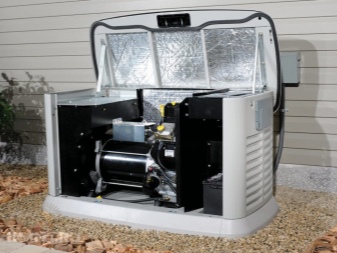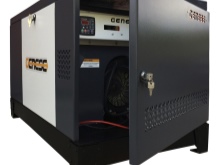All about main gas generators

The generation of electricity from diesel or gasoline is widespread. But this is not the only possible option. It is imperative to know everything about main gas generators, about their features and connection nuances.
Peculiarities
A conversation about a gas generator from a main gas pipeline should start with the fact that such devices are economical. After all, "blue fuel" is relatively inexpensive. In addition, an electric generator connected to the mains for the home is quieter than liquid-fuel counterparts. After all, no internal pump is needed to supply gas. The total resource of the equipment is about 5000 hours. For comparison: on average, maintenance and overhauls are needed for devices with a liquid internal combustion engine every 1000 hours.
It is mandatory to use electronic control block. It controls the operation of all the main components of the generator. Also, the electronics monitors the maintenance of constant pressure, the stability of the electrical voltage. Frame (body) in some models, it can protect the main structural elements from the harmful effects of the external environment.
Of course, in any case, it improves the appearance of the product.


The difference between the individual versions is expressed in:
number of phases;
the amount of current generated;
work on natural or liquefied gas;
cooling option;
start option;
presence or absence of a voltage controller;
the level of electrical protection (according to the IP standard);
generator size;
the volume of the noise being emitted.


Model overview
Hybrid gas generator "Spec HG-9000"... The delivery set of a single-phase device includes everything you need to connect to the mains and to the cylinders. During operation, the sound volume reaches 68 dB. Other technical properties are as follows:
weight 89 kg;
rated power 7.5 kW;
synchronous alternator type;
the ability to switch to gasoline;
4-stroke engine with 460 cc working chamber volume cm.;
direct current with a voltage of 12 V.

A good alternative turns out to be Mirkon Energy MKG 6 M. The power of this generator is 6 kW. By default, it is shipped with a cover. You can use both regular and liquid gas. The sound volume reaches 66 dB.
Other nuances:
inline motor;
1 working cylinder;
combustion chamber capacity 410 cu. cm.;
oil sump capacity 1.2 l;
engine rotation frequency 3000 rpm;
air cooling;
mechanical speed controller.


But if you need to choose a gas generator with auto start, then the best choice may be Briggs end Stratton 040494. The power reaches 6 kW. This model is for standby use only. The manufacturer declared the engine resource to be at least 6000 hours. The longest time of continuous work is 200 hours.
Key nuances:
combustion chamber volume 500 cm;
air cooling system;
oil level control option;
crankcase capacity 1.4 l;
overload protection system;
system for calculating engine hours.



The next model on the list is "FAS-5-1 / LP". The device is designed to generate 5 kW of current. The voltage in the network reaches 230 V. A single-phase current is generated. The main drive is purchased by the manufacturer from Loncin.
Technical specifications:
amperage 21.74 A;
electric starter;
sound volume 90 dB;
closed version (suitable for outdoor use);
admissibility of round-the-clock non-stop work;
plastic case;
total weight 90 kg;
air cooling;
operating frequency of revolutions 3000 per minute;
Russian-language control unit;
automatic control system.


Optionally can be added:
synchronization and cogeneration units;
containers;
automatic input blocks (triggered in 7 seconds);
accumulators;
pallet heating systems;
battery charging systems;
ABP shields.


Completing the review is quite appropriate with a gas generator. Genese G17-M230. The device is declared as an assistant in the main and backup power supply. A four-stroke engine with 4 cylinders is installed inside. The engine is made according to the in-line scheme and has the upper position of the valves. The shaft is horizontal, and a special fluid circuit is responsible for cooling.
The shaft is made of steel, it is processed by forging. In this case, the cylinder liner is made of cast iron. The supply of lubricant under pressure is provided. Thanks to the increased compression, the overall performance is increased. The electronics provide faster start-up. The designers claim to have foreseen the possibility of using the generator in harsh conditions.
Technical specifications:
weight 440 kg;
generated power 14 kW;
power factor 1;
single-phase version;
electric and automatic starting modes;
hourly gas consumption 8.5 l;
sound volume during operation 80 dB (at a distance of 7 m);
level of electrical protection from IP21;
oil level drop protection system;
lack of inverter mode;
electronic motor speed controller.



How to connect?
The main difficulties in connecting the generator to the backbone network are by no means technical in nature. Be sure to have to agree on a lot of documentation, draw up a number of schemes... In any case, the quality of ventilation must be monitored. The gas generator must be well ventilated. If the air movement is insufficient, the efficiency of the power plant decreases.
The generator system must not be installed in rooms with a volume of less than 15 cubic meters. m. If the device is designed for liquefied gas, it is prohibited to place it in the basement. Another nuance is the competent provision of exhaust gas removal. The buildings provide for a separate chimney. In open areas, local conditions are taken into account.
Otherwise, there are no special differences from the connection to the cylinder. For connection use gas reducer. A standard shut-off valve is connected to it, between which a certified hose is drawn and the generator. Connect the hose to the motor connection.
The device must be grounded, and for joint use with external sources, an electrical distribution board is needed.


See below for an overview of the gas generator.













The comment was sent successfully.